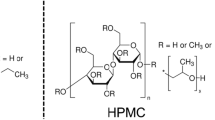Abstract
The preparation and characterization of active-loaded microparticles for cosmetic textile applications were studied in this work. The double emulsion diffusion/evaporation technique was served and the Eudragit® RS100 (ethyl acrylate and methyl methacrylate copolymers) was used as biodegradable polymer. Two actives molecules, vitamin E and Lauryl isoquinolinium bromide (LIB) were successfully loaded during the formulation. Obtained particles were spherical in shape with a little variable diameter about 1 μm and zeta potential of 55 mV. The cutaneous penetration of the particles was evaluated by dermal microdialysis, tape stripping, and punch-biopsy techniques from ex vivo human skin. LIB or vitamin E concentrations in the different layers of the skin were analyzed by high-performance liquid chromatography method. Finally, these particles were adsorbed onto a textile in optimized conditions. The scanning electron microscopy is used to confirm the total threads coverage by particles.








Similar content being viewed by others
References
Freiberg S, Zhu XX (2004) Polymer microspheres for controlled drug release. Int J Pharm 282:1–18. doi:10.1016/j.ijpharm.2004.04.013
Tran V-T, Benoît J-P, Venier-Julienne M-C (2011) Why and how to prepare biodegradable, monodispersed, polymeric microparticles in the field of pharmacy? Int J Pharm 407:1–11. doi:10.1016/j.ijpharm.2011.01.027
Uhrich KE, Cannizzaro SM, Langer RS, Shakesheff KM (1999) Polymeric systems for controlled drug release. Chem Rev 99:3181–3198. doi:10.1021/cr940351u
Rosen M (2005) Delivery system handbook for personal care and cosmetic products: technology, applications and formulations. William Andrew
Khan MS, Vishakante GD, Bathool A (2012) Development and characterization of brimonidine tartrate loaded Eudragit nanosuspensions for ocular drug delivery. J Colloid Sci Biotechnol 1:122–128. doi:10.1166/jcsb.2012.1008
Pignatello R, Bucolo C, Puglisi G (2002) Ocular tolerability of Eudragit RS100® and RL100® nanosuspensions as carriers for ophthalmic controlled drug delivery. J Pharm Sci 91:2636–2641. doi:10.1002/jps.10227
Ibrahim HK, El-Leithy IS, Makky AA (2010) Mucoadhesive nanoparticles as carrier systems for prolonged ocular delivery of gatifloxacin/prednisolone bitherapy. Mol Pharm 7:576–585. doi:10.1021/mp900279c
Sipos P, Csóka I, Srčič S, et al. (2005) Influence of preparation conditions on the properties of Eudragit microspheres produced by a double emulsion method. Drug Dev Res 64:41–54. doi:10.1002/ddr.10425
Das S, Suresh PK, Desmukh R (2010) Design of Eudragit RL 100 nanoparticles by nanoprecipitation method for ocular drug delivery. Nanomed Nanotechnol Biol Med 6:318–323. doi:10.1016/j.nano.2009.09.002
Chattopadhyay P, Huff R, Shekunov BY (2006) Drug encapsulation using supercritical fluid extraction of emulsions. J Pharm Sci 95:667–679. doi:10.1002/jps.20555
Esposito E, Roncarati R, Cortesi R, et al. (2000) Production of Eudragit microparticles by spray-drying technique: influence of experimental parameters on morphological and dimensional characteristics. Pharm Dev Technol 5:267–278. doi:10.1081/PDT-100100541
Ogawa Y, Yamamoto M, Okada H, et al. (1988) A new technique to efficiently entrap leuprolide acetate into microcapsules of polylactic acid or copoly(lactic/glycolic) acid. Chem Pharm Bull (Tokyo) 36:1095–1103
Matos M, Gutiérrez G, Coca J, Pazos C (2014) Preparation of water-in-oil-in-water (W1/O/W2) double emulsions containing trans-resveratrol. Colloids Surf Physicochem Eng Asp 442:69–79. doi:10.1016/j.colsurfa.2013.05.065
Mary S, Muret P, Makki S, et al. (1999) A new technique for study of cutaneous biology, microdialysis. Ann Dermatol Venereol 126:66–70
Leveque N, Robin S, Makki S, et al. (2001) Iron concentrations in human dermis assessed by microdialysis associated with atomic absorption spectrometry. Biol Pharm Bull 24:10–13
Tavakkol A, Nabi Z, Soliman N, Polefka TG (2004) Delivery of vitamin E to the skin by a novel liquid skin cleanser: comparison of topical versus oral supplementation. J Cosmet Sci 55:177–187
Cichewicz A, Pacleb C, Connors A, et al. (2013) Cutaneous delivery of α-tocopherol and lipoic acid using microemulsions: influence of composition and charge. J Pharm Pharmacol 65:817–826. doi:10.1111/jphp.12045
Dhananjeyan MR, Bykowski C, Trendel JA, et al. (2007) Simultaneous determination of procaine and para-aminobenzoic acid by LC-MS/MS method. J Chromatogr B Anal Technol Biomed Life Sci 847:224–230. doi:10.1016/j.jchromb.2006.10.004
Yang Y-Y, Chung T-S, Ping Ng N (2001) Morphology, drug distribution, and in vitro release profiles of biodegradable polymeric microspheres containing protein fabricated by double-emulsion solvent extraction/evaporation method. Biomaterials 22:231–241. doi:10.1016/S0142-9612(00)00178-2
Crotts G, Park TG (1995) Preparation of porous and nonporous biodegradable polymeric hollow microspheres. J Control Release 35:91–105. doi:10.1016/0168-3659(95)00010-6
Meng FT, Ma GH, Qiu W, Su ZG (2003) W/O/W double emulsion technique using ethyl acetate as organic solvent: effects of its diffusion rate on the characteristics of microparticles. J Control Release 91:407–416. doi:10.1016/S0168-3659(03)00273-6
Acknowledgments
This work has been achieved in the frame of Texactiv research program and has been supported by French public agency, OSEO.
Author information
Authors and Affiliations
Corresponding author
Rights and permissions
About this article
Cite this article
Bitar, A., Zafar, N., Valour, J.P. et al. Elaboration of sponge-like particles for textile functionalization and skin penetration. Colloid Polym Sci 293, 2967–2977 (2015). https://doi.org/10.1007/s00396-015-3704-7
Received:
Revised:
Accepted:
Published:
Issue Date:
DOI: https://doi.org/10.1007/s00396-015-3704-7




